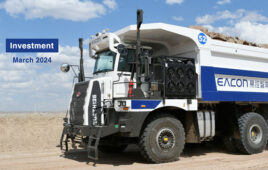The U.S. needs help with inspecting and repairing its aging pipes, power lines, and other utilities. Providers are turning to infrastructure robots and aerial drones.

|
Listen to this article
|
If you’ve driven on American roads this holiday week, think of what’s needed to make your vacation possible and to keep our economy humming. The U.S. is rightly proud of its interstate highway system, which began in the 1950s and has helped tie the country together and led to decades of economic growth. However, the nation’s bridges, railways, and utilities now urgently require attention. Infrastructure robots should be a significant part of the solution.

Content sponsored by ULC Robotics.
The American Society of Civil Engineers last year gave the country a “D+” grade and estimated that the government needs to invest more than $2 trillion over the next decade on modernization. The U.S. Chamber of Commerce has agreed.
As a presidential candidate, Donald J. Trump promised to spend $1 trillion on such investments. Since then, the Trump administration has proposed $200 billion in government funding and said it expects to make up the difference with private investment.
No matter where the money comes from and when, the scale of needed repairs and upgrades is too big to expect the existing workforce to be sufficient.
Utilities recognize need for infrastructure robots
Less visible than potholes but just as critical to the health of business and safety of U.S. residents are power lines, pipelines, and other monitoring systems. Utility providers are learning to be more proactive, thanks to aerial drones, underground robots, and predictive maintenance, all enabled by big data and the Internet of Things.
Researchers worldwide are working on systems for preventing leaks in water pipes, and robots are already responding to the need to find and prevent problems with utility delivery.
“Utility companies often look to our robots to remotely inspect and repair difficult to access infrastructure, or to help comply with regulatory requirements and prevent accidents,” said Robert Kodadek, chief technology officer at ULC Robotics.
The Hauppauge, N.Y.-based company’s CISBOT and CIRRIS robots can inspect and patch live gas mains. The technology only requires a single 6-in. excavation to access the mains, a process drastically less disruptive to the environment and the public than traditional excavation methods. It also allows for a significant decrease in overall project emissions.

ULC Robotics has conducted inspections in the U.K. Source: ULC
In 2015, ULC was deploying just two CISBOT robots. By 2018, the total was brought up to eight robots in the field, with two more in production. The use of these robots has continued to grow with the need for safer and more effective utility operations, as well as compliance with infrastructure maintenance mandates.
“Gas utilities are working to address their leak-prone cast-iron gas mains,” Kodadek told Robotics Business Review. “But the reality is that they can’t replace every main — it would just be too costly for the utilities and their customers.”
Inspections and repair of miles of critical infrastructure across urban, suburban, and rural areas fall well within the “dull, dirty, or dangerous” work ideal for automation, as a recent British report noted.
While underground robots are working every day to reduce excavations for certain types of repairs, utility companies still need to generate hundreds of excavations per day. According to an article in The Telegraph in 2010, 300,000 holes are dug every year in London for roadworks, causing 36% of the city’s traffic delays. These traffic delays cost London businesses $1.3 billion.
In an effort to minimize public disruption and costs associated with excavations, ULC Robotics and SGN are developing robots capable of carrying out excavations in the street. By reducing the need for traditional heavy construction equipment, gas utilities and other entities can improve the safety and efficiency of excavation while minimizing the impact of the work on society and the environment.
“In a world where we have smartphones, smart cars, and smart homes, the way utilities excavate in the street has not changed all that much.” said Kodadek. “Our team is working to combine robotics, machine learning, and AI to completely transform the excavation and construction markets.”

ULC’s VTOL-capable UAV saves utilities the time and expense of line workers or aircraft inspections.
UAVs add eyes in the sky
Many marine robots are used for inspecting offshore oil rigs, and their airborne cousins are just as useful for electrical transmission and cellular towers dotting the landscape.
Precision agriculture and environmental assessment/exploration have already been taking advantage of unmanned aerial vehicles (UAVs).
Bridges, building sites, wind turbines, and more could benefit from more infrastructure robots. In addition, drone inspections could be a billion-dollar market, according to some estimates.
According to Forbes, 34 states hope to save money and staff time by using drones for inspections and monitoring.
RaaS to the rescue
Liquid natural gas and electric companies intersect in their interest in using infrastructure robots as a service (RaaS). In response, many drone makers have pivoted over the past few years to serve the commercial market rather than the consumer one.
Companies already serving the energy industry have a great advantage in understanding its needs.
ULC Robotics has been actively partnering with utilities to conduct inspections of towers, right of ways, substations, and more.
ULC’s UAVs are fixed-wing drones with vertical takeoff and landing capabilities. They include different sensors that were custom-developed for electric and gas clients.
“Our UAV teams are inspecting a variety of critical infrastructure, from transmission and distribution lines to power plants,” said Kodadek. “Our customers are seeing the benefits that UAVs deliver, and we’re scaling up our teams to meet growing demands.”
While Washington debates on how to pay for needed improvements so that urban and industrial areas don’t strangle themselves, utility providers should continue to look to infrastructure robots to better serve their customers.
With relatively few companies in the infrastructure inspection and maintenance space, utility providers should have little difficulty finding robots to help them, once they realize that automation can extend human efforts.





